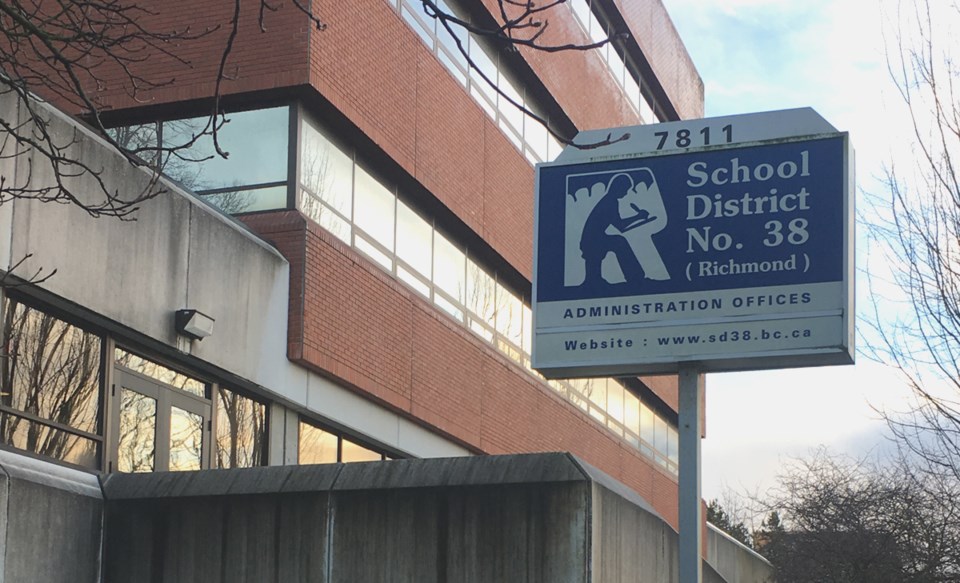The Richmond board of education hopes the public will give feedback on a wide range of issues it's facing.
Richmond school district released a list of strategies in its Long-Range Facilities Plan (LRFP) to better use extra space in schools, including tweaking catchment boundaries, choice programs, using space for community health, social services and child care, and “consolidation of school populations” to reduce surplus capacity.
The LRFP doesn’t have any recommendations for school closures, although there is discussion of some consolidation of school catchments.
The first open house will be at MacNeill secondary, 6611 No. 4 Rd., on April 4 from 6 to 8 p.m. Feedback is also being gathered through the LRFP website at www.letstalksd38.ca.
The LRFP gives an overview of programs, enrolment projections, future trends and transportation of students. It’s intended to give a rationale for capital investments and helps determine the Ministry of Education’s annual facilities grant. It also helps the school district make local decisions about the best way to use its facilities, where programs should be located and how to address low enrolment and maintenance priorities.
According to the district communications officer, David Sadler, the board is committed to developing a “transparent LRFP” and must discuss all options, including school consolidation, when addressing issues facing the district like low enrolment, the condition of the facilities, seismic rating and “viable educational programming.”
“There is no current timeline for the implementation of recommendations until a thorough consultation process with stakeholders and public is completed,” Sadler explained in an email.
When asked about the difference between school closures and school consolidations, Sadler said with consolidation, a school could be used as swing space while upgrades are taking place at another school, the school could be repurposed, for example, for a learning centre, or the school could be leased to another educational provider, like the former Kilgour elementary which is now a French-language school under the Conseil scolaire francophone de la Colombie-Britannique.
Any eventual school closures would follow consultation requirements that the School Act has outlined and board policy.
The school district is divided into four main areas in the draft Long-Range Facilities Plan, calling them “communities of schools:” North Central, East, South Central and West.
In the north central area, as the area is densifying especially in the city centre and the number of students is expected to grow, the school district is trying to find a new school site or "air space." Projections show that there will be a shortage of space in the four city centre elementary schools, Cook, Talmey, Tomsett and Brighouse, with 724 too few seats by 2027 and 1,151 by 2033.
In this quadrant of Richmond, only Sea Island elementary is “significantly” below operating capacity, and the report notes it might not be “sustainable” because of the small school population and “maturing trends” in Burkeville. Currently, there are 35 students at the school, which runs kindergarten to Grade 1 classes, but this is projected to decline and eventually level out at 12 by 2024. The report suggests one possibility is combining the Sea Island catchment with the Brighouse elementary catchment.
The east community of schools, which includes everything east of Hwy 99 all the way to Hamilton, has enough capacity to take in future growth. An expansion of four classrooms at Hamilton elementary has been proposed.
The south central community of schools includes four high schools, Steveston-London, McRoberts, Palmer and McNair. All of them are below capacity and not expected to grow in population, with this note: “A consolidation of McNair Secondary and McRoberts Secondary catchments as a single secondary school catchment may be possible” if the French program moves from McRoberts to Palmer.
There are 439 surplus seats in south central elementary schools as of September, and this is expected to rise to 644 by 2023 and then drop down to 502 by 2033. The report notes that total extra space is projected to be the equivalent of two medium-sized elementary schools.
The condition of the elementary schools in south central range from fair to poor, and 12 of the 15 have a “high seismic risk.” Four schools in this area, however, Bridge, Whiteside, McKinney and Maple Lane, are moving forward in the seismic mitigation program, an announcement that was made at the March 13 school board meeting.
In the west community of school, six of the 12 elementary schools have surplus space with 630 extra seats. Two high schools also have extra space, Hugh Boyd and J.N. Burnett, and a planned seismic upgrade project for Boyd will reduce the number of seats from 900 to 800.
Elementary schools in the west community of schools currently have 630 seats. This is projected to increase to 777 by 2023 and then go down to 602 by 2033. The report proposes “school catchment consolidations” to decrease the number of extra seats by September 2021.
Discussions will take place with Ministry of Education about the optimization of space as a follow-up to the LRFP, according to Sadler.
International students are not included in the calculations of extra capacity.



